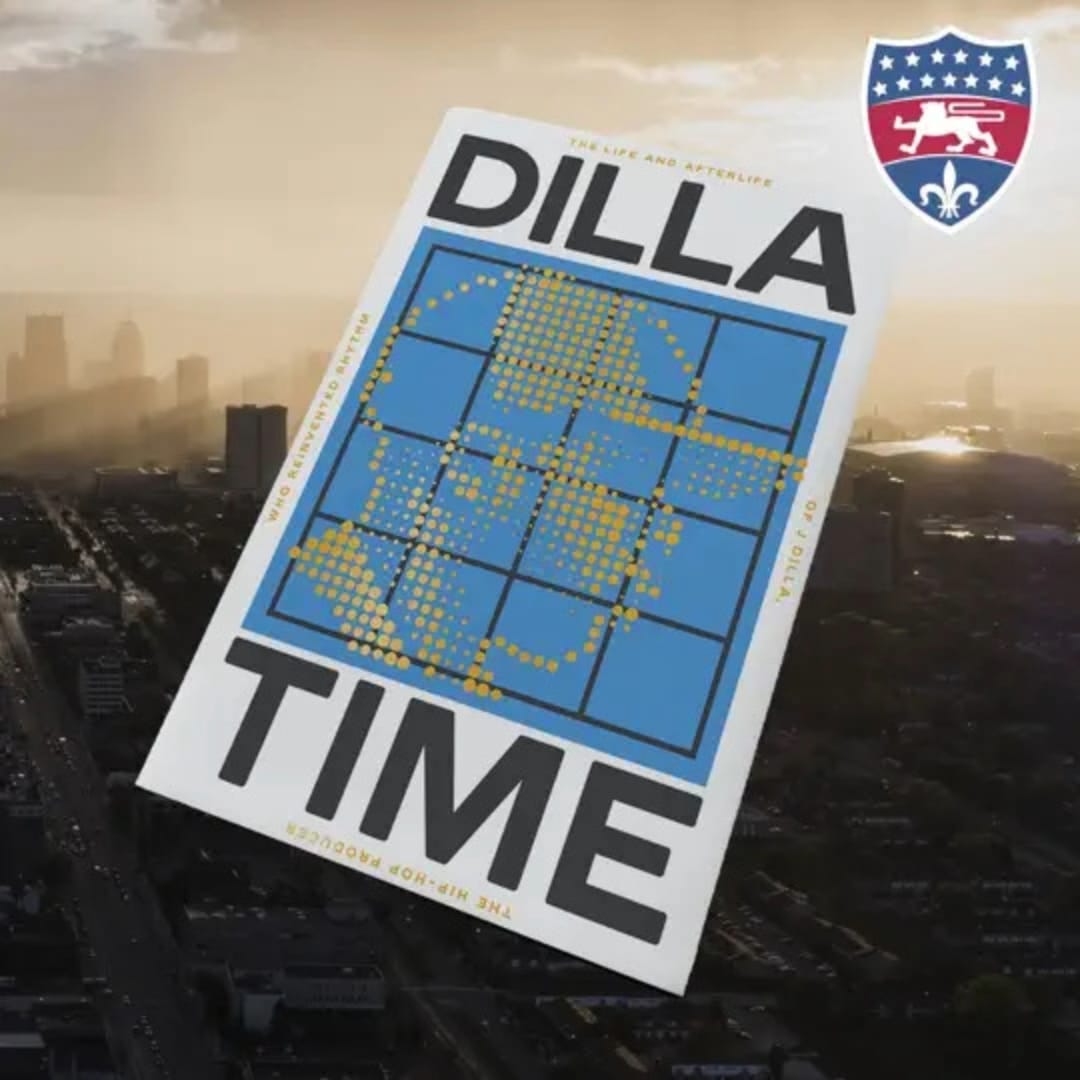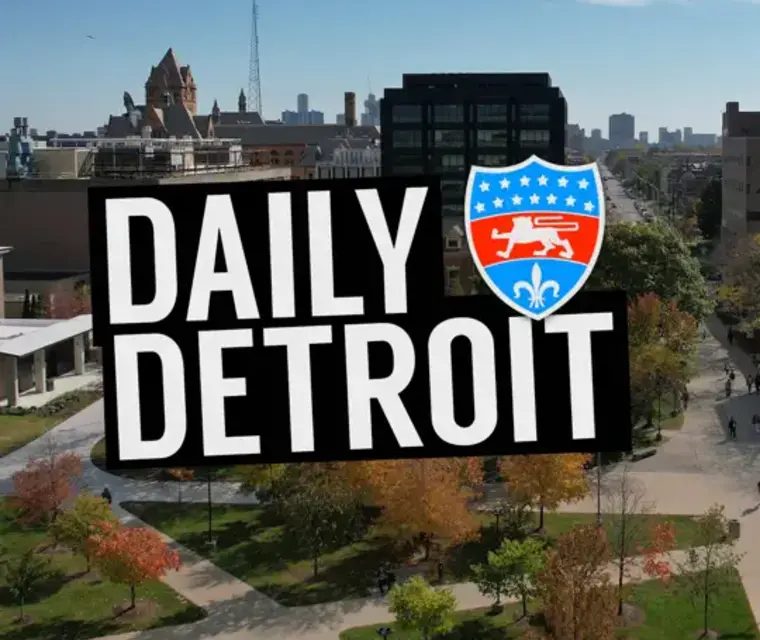Dan Charnas is my guest today as we explore the life and legacy of musician and producer J Dilla.
Dan's new book, "Dilla Time," is described as equal parts biography, musicology, and cultural history and it was a fascinating read.
Order the book from your favorite independent bookseller or get the book: https://www.amazon.com/Dilla-Time-Afterlife-Producer-Reinvented/dp/0374139946
Daily Detroit posts every weekday sharing what to know and where to go in southeast Michigan.
We are supported by our members on Patreon and local supporters. You can help us continue telling your stories by joining our Patreon: http://www.patreon.com/dailydetroit
Follow the podcast on Apple Podcasts, Spotify, or wherever you get shows.
Or sign up for our newsletter: https://www.dailydetroit.com/newsletter/
Scroll down for the episode transcript.
Jer Staes: To tell the story of the genius of someone like J. Dilla, I think you link it to his family, his lineage, and you also link it to a city that has produced, it has been the matrix for so much incredible culture.
That's the voice of Dan Charnas. He's my guest today as we explore the life and legacy of musician and producer J. Dilla. Dan's new book, “Dilla Time” is described as equal parts biography, musicology, and cultural history, and it was a fascinating read about one of Detroit's own. So, happy Valentine's Day. Coming to you from a snow-covered North End, I'm Jer Staes and this is episode 922 of Your Daily Detroit for Monday, February 14th, 2022. Let's just jump into it.
Joining me virtually is Dan Charnas. He is the author of “Dilla Time: The Life and Afterlife of J. Dilla, the Hip-Hop Producer Who Reinvented Rhythm.” I don't know if there's a more accurate book title that I've ever seen in my life.
Dan Charnas: Thank you. I, I think so too.
Jer Staes: So, how did you come across the story of J. Dilla, because you yourself are not from here?
Dan Charnas: No, I'm, I'm a New Yorker, but you know, I was involved as both a journalist and a producer executive in hip-hop since the late 1980s. And in the 1990s, I was living in Los Angeles as a record executive. I worked for a guy named Rick Rubin, who was a co-founder of Def Jam. Long story short, I ended up flying out to Detroit in 1999 with an artist of mine to get beats from this incredible Detroit producer named J. D. And, you know, before J. D., very little hip-hop had come out of Detroit of national importance. And so we made the pilgrimage to the basement out in Conant Gardens. Common was there, the rapper Common. We stayed for three days, and then we left. And the crazy thing is, I brought my camera with me, and the only pictures I took were of what I thought was the most historical thing, right? The Motown Museum.
I didn't bring my camera to the basement where I would later come to realize some more present history was being created.
Jer Staes: You know, reading this book, I saw a parallel. And, tell me if I'm crazy, but I saw a parallel between the story of the Funk Brothers in Motown and J. Dilla, in that, at the time, so many people in the mainstream may not have known, you know, there were albums later on that people got to know, you know, you got “Donuts” and you got some things like that. But, early on, there was so much work that J. Dilla did that you didn't realize that, like, that was the sound. Like, the vocals were important, but the sound was driven by somebody that was not maybe not on your radar, unless you were into that cassette passing scene or had a cool friend.
Dan Charnas: Yeah, this was a kid from Detroit who had a lifelong struggle essentially to find his name. Not just to make it, but to find it. He was plucked out of obscurity in Detroit by a very famous rapper Q-Tip from A Tribe Called Quest and introduced to all of Q-Tip's friends, so the classic rap acts from the 90s, De La Soul and Busta Rhymes, and the Roots and Common, and D'Angelo. But through this time, J. D., as he is calling himself, is not able to be solely credited for his work, because he has become part of this production collective called the Uma, where everything is credited to the collective. So it took him years, like the first part of his career, to sort of create a name for himself, and by then he had changed his name from J. D. to J. Dilla.
Jer Staes: So, going through this, from a journalistic perspective, did you ever find it difficult to kind of square up stories? Because when I read the book, I saw a lot of times where someone would say X, and the other would say Y. Is, is that part of what's kind of built up the mythos of everything? Because when you talk to people in Detroit, people believe one way or another. And I know times you tried to find what it was, but you kind of told both the best you could.
Dan Charnas: Well, it makes sense, right, that Dilla's rhythmic signature was rhythmic conflict, right? That is what you're hearing when you hear a J. D. beat and why people all over the world have imitated it. So it makes sense that his life and his legacy also have a lot of conflict, interpersonal conflict. There are friends who have different opinions from the family and different versions of the facts. There are different family members who have different versions of the facts. And what I tried to do as a reporter, if I could not get, confirmation of a particular scene or a particular fact, and I couldn't get a police report or whatever kind of documentation I needed from the court, I simply present the two versions to the reader on the page, sometimes in a footnote, to help the reader understand the nature of the conflict and the contention thereof.
Jer Staes: How did it feel for you emotionally, going so deep? And I don't know how long you spent working on this book, but how did it feel emotionally covering someone that you had met and that you knew?
Dan Charnas: Oh, man. Well, well, the other part, thanks for that question, by the way. I spent four years. I did interviews with almost 200 people, but something like 400, at least 400 individual sessions with folks. And, at times, it felt like I was doing marriage counseling on 200 people at once. Dilla's music is very emotionally evocative, and he attracted people to him in ways that people cannot even explain. People who were in his life who tried to keep him alive. People who were in his life, you know, he wasn't very nice to at times, right? Still have these incredible and, sometimes, again, conflicted emotions toward him. So it was quite an emotional journey for me, who I also have, listen, I, I met him. I never considered myself a close friend of his, but there is this thing, right, about J. Dilla that draws people to him, and I am no exception for that. So I have my own, my own emotions to deal with as well, while reporting and writing this book, for sure.
Jer Staes: Another thing that I noticed was you use graphics in the printed version in a way that I feel like, whether you do the audiobook or do the printed version, I think you need to get your hands on the printed version as well, because the graphics in there, you lay out the beats in ways. And to me, that was fascinating, and you laid it out in a way that, even for someone who is not a musician, I was like, oh, I can tap along to this. I can visually see what you're talking about.
Dan Charnas: Right. Well, and this is where Detroit really comes into the picture for me. Because what I needed to do was explain why J. Dilla is important to people who don't know music. And so I decided to do that through grids, right? Not musical notation, not notes and staves, but grids. And a very interesting grid to use to teach sort of the musical principles is the street plan of Detroit, which is a conflicted grid plan, right?
Jer Staes: Oh very much so.
Dan Charnas: Yeah, well, you know, especially downtown Detroit. You know, good luck driving around downtown Detroit if you really don't know the city like the proverbial back of your hand.
Jer Staes: Oh, how many times have I gotten that call. So as we're doing this interview, I'm looking at my back window, I can see the Fisher Building. And, for me, I am that friend, among some other friends of mine, where it's like, oh, I'm from wherever and I'm caught at this corner and this corner, and what do you mean that there's an East Grand River? I had no idea there was three blocks of East Grand River. You know? And, funnily enough, that East Grand River, goes right into Dilla's childhood neighborhood, which is another thing that blows my mind as a longtime resident. To me, I feel like people who go by what's now known as The Ashley they should know about these things. I mean, yes, there was Uncle Herm's Donut Shop, but it goes down to this idea of, like, I think there should be those kind of physical markers of the people that have impacted Detroit in more ways than say, you know, you put up the Spirit of Detroit or whatever. Like, these individual things where this was J. Dilla's childhood place. Like, those are the kind of things that I think would be important to add context, and I think there will be a lot of people who, when they read this book, this will be the first time that they realize that connection to that building that's, you know, literally like a block away from the Detroit Athletic Club. A block away from where the most powerful people in this city hang out. You have the contrast of how J. Dilla grew up.
Dan Charnas: Yeah, well, you know, and I don't blame Detroit for that at all, because you need resources in order to have active preservation of your history, right? And so much of Detroit over the years has been erased by redevelopment, by highway building, by all these, you know, by economic deprivation, right? So I think Detroit will get there. I think Detroit is starting to really understand those treasures, you know, especially around Dilla. But, yeah, I, I, I, I agree.
Jer Staes: So, what about Detroit's history called to you? Because there's also a Detroit history lesson in here. And not just around J. Dilla's life, but all the different things that societally impacted Detroit over the years. You know, I've read Thomas Sugrue's “Origins of the Urban Crisis,” a bunch of, like, these deep books. But this might be the book where I'm like, maybe you want to onramp here because this is about a topic that you can bridge you into before you get into, and I, I love Thomas Sugrue's work, but that's basically a textbook.
Dan Charnas: Well, who? I mean, because I love Sugrue as well. It makes me very, I don't know, proud to think that I could be an onramp for Sugrue, but, to your point, to tell the story of the genius of someone like J. Dilla, I think you link it to his family, his lineage, and you also link it to a city that has produced, it has been the matrix for so much incredible culture. And the stories are very much aligned, right? So you have a neighborhood whence his family came, right? You know, his family came up in the Great Migration. You know, they lived in Black Bottom and Paradise Valley. And then those places get erased. And so what does that do to a family? What does that do to the culture that came out of that matrix? That's why you have the emergence of things like techno, and then later the music of Detroit hip-hop as well. It, it comes as a result of those broken grids and broken agreements and conflict that's actually on the map, you know, it's on the ground.
Jer Staes: Yeah, and it's interesting to see how those roads, how that even plays into development today. And when you see situations where there's a broken grid, there's a grid laid over a grid. And then, you know, in places like the Near East Side, you're talking about the erasure of Black Bottom, you then lay over a whole another street pattern where you couldn't even recognize, except for a couple key streets. You go over there on that Near East Side, you know, I have some friends that stay over there. I'm sure there's a lot of people who may not, who live there who may not know, like, what their neighborhood used to look like within their parents' lifetimes.
Dan Charnas: Yeah, right over there on Gratiot, just a few blocks east of Eastern Market, there's a mural that I love, and it's like a cartoon character of a kid sort of speaking into this talk bubble, and he says, "Detroit never left." And that's sort of been a motto for me in my writing, because I know when people, especially people from outside, write about Detroit, they tend to write about this Renaissance narrative. They tend to write about Detroit as if it's a ghost, but it isn't. You know, Detroit never left. A city is a home to its people, and so what I tried to do in the book is to show that life. To show how, you know, in the 1980s, you know, the jitterbug sort of created a whole new dance culture, and how James and his friends in Conant Gardens, you know, between Six and Seven Mile, you know, they grew up in this culture. Uh, how hip-hop sort of squeezed its way into Detroit and, and made spaces for itself, whether it's Saint Andrews or the Rhythm Kitchen, or at the hip-hop shop. All of these things, and then a community, right? These people, these kids who were living in Detroit, who would go on to do amazing things. You know, not just J. Dilla, but Jessica Care Moore and Waajeed, and, and T3, all of these and Paul Rosenberg, and Eminem, right? All of these people came from this matrix, and it was a, an honor and a duty to tell that history.
Jer Staes: You talk about Detroit never left. That makes me think of something I've heard a lot over the years, the idea that, you know, some people will say Detroit is a blank canvas, and I say that's the absolute reverse of what it is. And it gets me so upset when I see that in the media, and I still hear it to this day. When people, you know, will maybe mention that, especially if it's in a conversation where I can speak up, it's something where, you know, if Detroit were a blank canvas, it wouldn't be as compelling as it is.
Dan Charnas: No question. No question. Nothing blank about it.
Jer Staes: Yeah. If you want a blank canvas, move to 34 Mile Road or whatever, you know?
Dan Charnas: Yeah. Yeah, but you know what power does? If power wants to come into a place, power basically erases what's there, right? So that's just another kind of erasure. And that, that wasn't going to happen on my watch in this book.
Jer Staes: That's the importance of cultural institutions. You know, you even got into touching on, at one point, talking about, you know, the bankruptcy and the possibility that we could have lost the Detroit Institute of Arts, and I remember that, and that's a very real thing. And then bringing it full circle to finally start to include people, you know, and make progress even with the arts community here, to have an event like they did for J. Dilla and to see more things around J. Dilla appear. I think that's a beautiful thing.
Dan Charnas: Yeah, you're speaking of this really evocative and wonderful concert that brought an orchestra into the Rivera Court at the DIA in 2019 to play a suite of Dilla beats by an orchestra, right?
Jer Staes: That's amazing.
Dan Charnas: So it's like the cultural heart, the cultural institution of Detroit, bringing J. Dilla into an embrace. And at the same time, the donut shop at the Ashley, right, downtown, struggling, really struggling to make it. So there are ways in which Detroit supports its own, and there are also ways in which it's very hard for some Detroiters to feel seen and heard here. I think J. Dilla in his own life felt that Detroit radio in particular didn't really pay him much attention. Again, I don't blame Detroit for that. It was just sort of a way that hip-hop was in the 1990s that he really had to go to places like Los Angeles to, to get a little more visibility and respect. And frankly, in Europe, he was absolutely revered.
Jer Staes: Well, that echoes some sentiments though that I've heard with techno and electronic artists and things like that over the years, and I still hear them to this day. Like, you can fill a couple thousand seats in Europe, or, you know, you can go to another city, and they'll be like, there's a cache to Detroit. But here, you know, you got Herm with his donut shop that had a, you know, a big early open. And I went there more than a few times. Tasty donuts. Uh, and I like donuts. Tasty donuts. But, the idea being is that there is this difficulty in getting traction, and I'm glad to see that, like, the city has got a, you know, revitalized Arts and Culture Office and there's some things like that. But I wonder, what could be done or what could we do to inspire more local stuff to take root here? Because I keep watching that, like, that boomerang thing. Is that just a, a thing of, you know, travel, you know, helps raise your profile, or are there ways, you know, I don't feel like the same thing happens in New York or Chicago or LA or something like that.
Dan Charnas: If Herm had opened that donut shop in New York or LA, that donut shop would still be open. I have no doubt of it.
Jer Staes: Oh, 100%.
Dan Charnas: Yeah. I, and listen, again, I don't blame Detroit. I think that Herm put that donut shop in a place that was downtown and was very evocative for Dilla lore, because that was the building that he basically was born into, right? He lived there when he was a baby. But it ain't on Woodward. And that's where the foot traffic is. It could be as simple as that. I think that we have a chance though in the coming years to do some things to fold James Yancey into the lore and institutions of Detroit in ways that are even more formal than a mural, right? There are a lot of murals around Detroit of him, but I would love to see a street naming. I would love to see, you know, more sort of institutions like Pershing. I think has the J. Dilla Music Lab, right? Those are important, and I, and I, I think actually Detroit actually has created its own institutions in a way. I, I have to note Piper Carter's work with Dilla Youth Day.
Jer Staes: Oh, her work is amazing, 100%.
Dan Charnas: To go to the Wright Museum. I think the last time I went, went there might have been 2018 or 2019, and it was a joyous, you know, what was amazing is you had kids from out in the suburbs coming in, you know, with their parents, taking them to, to Dilla Youth Day at the Wright Museum, you know? So touching. I'll never forget it.
Jer Staes: I mean, Dilla Drive has a ring to it, if you ask me.
Dan Charnas: Dilla Drive definitely has a ring to it. Can turn Outer Drive into Dilla Drive. How about that?
Jer Staes: You know, you know things have changed a bit when, in the course of what we do, I get the press releases from the city and such. And when you see press releases for Dilla Day from the official city administration, that's something, you know what I mean?
Dan Charnas: Yeah. Yeah, it really is. But also, the hip-hop generation is aging into power, right? So there are people who are in power right now in the city who grew up on J. D.'s music. You know, they get it. And that's really how Motown eventually got places of honor in the city. It's just that you have to age into power sometimes.
Jer Staes: What's something while you were doing this book that you thought you knew that you learned through the research? Like, what is something that changed for you?
Dan Charnas: Ooh. Well, you know, I learned a lot about James Yancey's personal life, which was revelatory to me that's in the book. For me, it was chasing down some of these rumors, right? So his father, Beverly DeWitt Yancey, there had been a long, accepted as fact statement about him that he ghostwrote the song "It's A Shame" for the Spinners in 1970. And that song is actually credited to Stevie Wonder, Syreeta Wright, and Lee Garrett. And so I had to figure out is this really true? Because nobody seemed to have done the work. So, I went to DeWitt's ex-wife and she said she saw him writing the song. But then none of the people who were involved in the making of the song that I interviewed, Paul Riser, Dennis Coffey, G. C. Cameron, the lead singer of the Spinners, you know, confirmed any of it. You know, all signs pointed to Stevie Wonder writing that song, and even a representative for Stevie Wonder himself basically said, no, we, we didn't get that song from, from Dilla's dad. Those were the kinds of things that I spent, I was supposed an inordinate amount of time chasing down, but I also think that was sort of the, the heavy Detroit part of it. And that is a story that, again, it's very the the story of the father mirrors the story of the son. The father's search for success and to make a name for himself, and J. D., you know, had to go through the same thing a generation later.
Jer Staes: I think one of the things that adds interest to your book is the personal stories. You know, you could have just gone with a cold discography. You could have gone the route of, well, this song, this song, this song, but I think the personal interplay adds texture and understanding that gives you context for the art that he created.
Dan Charnas: I'm glad you think so. And it's funny, seeing people and witnessing people finally reading this book is for me a window into human behavior. There are some people who only want to relate to J. Dilla as a music nerd, and that's what they gravitate toward. So they like the music lessons, and some people like the intricacies of the Detroit history, but I take pride in having the opportunity to tell the story of the Yancey and the Hayes families, to tell the story of J. Dilla's, you know, James Yancey's own struggles to become an adult, right? He had a temper. He, you know, was not always kind to people, and yet he had this really, really almost unexplainable attraction for people. It's like everybody tiptoed around him. They understood him. It's almost like it was everybody's responsibility to take care of him and grow him up. And then, of course, the story of his own personal life, the mothers of his children, I had a chance to speak to both of them, and, you know, there's a lot of conflict around that as well. And, of course, he was diagnosed with an illness in 2003 that would basically plague him for the last three years of his life, and how difficult that was for everybody around him, and of course, how difficult it was for him. That was a particularly painful story to tell, but one that I don't feel I would have done my job if I hadn't.
Jer Staes: I feel like there is a contradiction in J. Dilla's story in that, and maybe you looked through a lot more materials than I did, but he wasn't somebody who granted a lot of, like, in-depth interviews. It wasn't something it, it was a contradiction where he really strided to have his name out there, but also during his life, it's not like you knew a lot about him. And I think that's part of what's so revelatory about what you did here.
Dan Charnas: He was a stutterer as a young boy. I mean, well, you're always a stutterer, you know? Like, a stammer is a neurological thing, right? And his father was a stutterer, and James had a stuttering issue. And, as a result of that, I think he refrained from talking a lot. And in refraining from talking, he became an almost supernatural listener. His skill really was listening. That's how he listened to records and listened to music and how he was able to pluck little fragments from records he heard way in the middle or at the end of a song that nobody else would have had the patience to listen to or hear, and create incredible digital compositions out of them. And it also went for him in personal life. I mean, I remember my trip to Detroit in 1999 to go work with him. I was talking the whole time. I was trying to entertain him. I was telling him a story about how we got thrown out of Canada the previous night. I was just, you know, talking, talking, talking, and what's James doing? He's just listening. And now I kick myself, of course, right? Because he was doing what I should have been doing. I should have learned from James. And so part of writing this book was learning how to listen for him now. And, yeah, he didn't give a lot of interviews because of that. But I will say this, there were some very, very skilled interviewers who got a lot out of him. And the reason they got a lot out of him is that they took the time to listen to his music, and they really got that he wasn't just some beat maker, some hot producer in hip-hop who worked with De La Soul. They very early on, even earlier than me, understood the level of genius that they were witnessing.
Jer Staes: What are a couple of tracks when you put them on that you can feel his presence?
Dan Charnas: Oh, that's a great question. So many. I think that his remixes are particularly evocative for me. There's a remix that he did for a group called the Brand New Heavies for their song "Sometimes" that even just listening to the instrumental is a wonder to hear how he, he lays notes down and gives space, and how he creates complexity in things. I think another good entry point for J. D. is the very first song that he released on a major label, commercially, which was "Runnin'" by the Pharcyde. It went top five on the rap charts. That's a very auspicious debut as J. D. There's a remix that he did of Jack McDuff's "Oblighetto" for Blue Note Records. It was his first and only release on Blue Note Records called "The Oblighetto Remix." Those are all, you know, great entry points for J. D., and also, of course, I always mention Slum Village's Fantastic Volume 2 album, which is his debut of his time feel, which has gone on to influence programmers and traditional musicians for the last 20 years.
Jer Staes: Great insights, Dan. You know, this book, I got to tell listeners, it was a joy to read. I really could not put it down because it intertwined so many things that are so important to me and my home, and, you know, no matter how you're coming at this, I think you're going to enjoy it. It's called "Dilla Time: The Life and Afterlife of J. Dilla, the Hip-Hop Producer Who Reinvented Rhythm." Dan Charnas, thank you so much for your time today on Daily Detroit.
Dan Charnas: Thanks for having me, Jer.
Jer Staes: Real quick, a favor to ask, if you found this episode valuable, consider supporting the show either by sharing it with a friend or chipping in at buymeacoffee.com/dailydetroit. Tomorrow, Fletcher Sharpe, we have a giveaway plan for you, our dear listeners to tell you about as well as some Detroit City FC news and so much more. I'm Jer Staes, thanks for listening. Take care of each other, and I'll see you around Detroit.


















